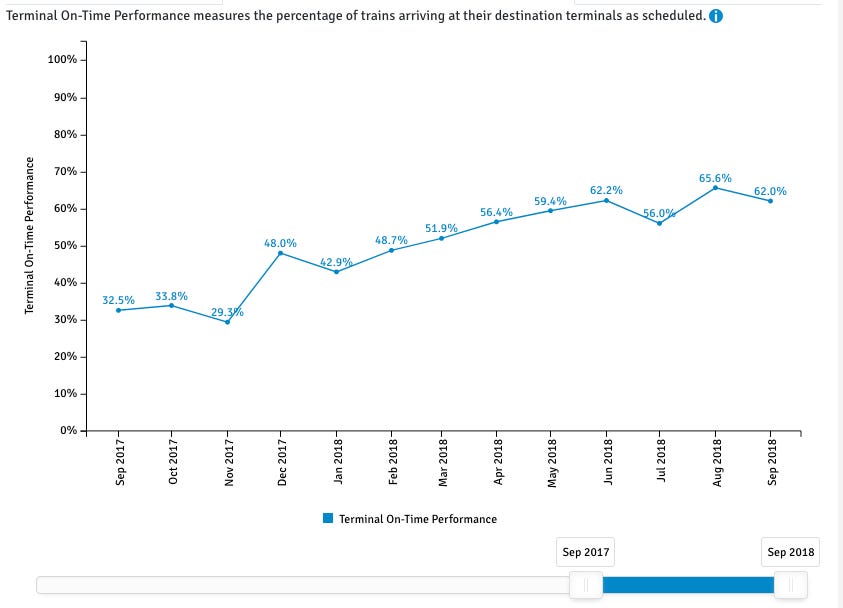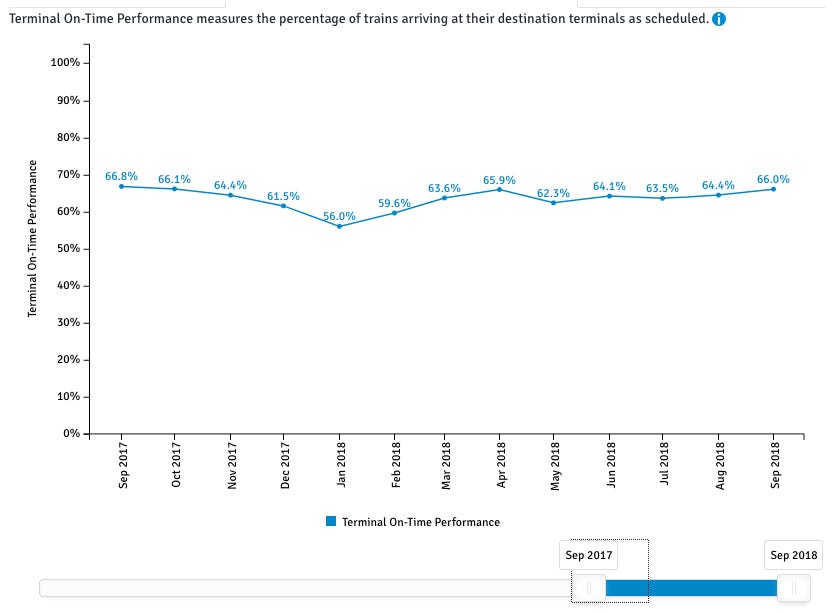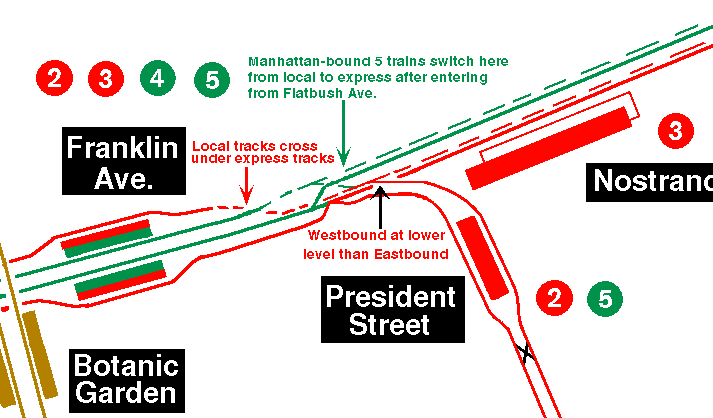Is The Subway...Getting Better?
For the first time since this newsletter began, I come to your inbox with good news. The subway performed better in September than in any month in recent memory. Some of the quick highlights from the most recent performance report:
Weekday Major Incidents were down 35 percent versus the same month last year, and down almost 7 percent over last year as a 12-month rolling average
Weekday delays decreased by 17.5 percent over the same month last year, and the 12-month rolling average is down 1.1 percent.
Weekday On-Time Performance likewise improved 4.4 percent over last year, and 1.4 percent as a 12-month rolling average.
And with that, I declare the subway fixed. Have a good one!
But seriously, nobody at the MTA is hanging up any “Mission Accomplished” banners any time soon; one month doesn’t make a trend. Further, the 48,212 delays in September are still a lot of delays. Straight historical comparisons are tricky because NYCT has improved its ability to measure delays over the last decade, but it roughly aligns with the number of average monthly delays the system experienced in 2016. That’s bad, because 2016 is towards the tail end of the decade-long performance decline.
All that being said, there is one aspect of the delay figures that warrants a deeper dive. It’s about the subway’s schedule, and why it matters.
Pretty much every metric is rooted in the subway schedule. Does a train arrive at its last stop within five minutes of the scheduled arrival time? Are customers’ journeys taking more than five minutes longer than the scheduled journey time? Etc. In this sense, the schedule is the goal, and every metric is asking, in a slightly different way, whether the subway is meeting that goal.
But, measuring performance this way is complicated by the fact that NYCT routinely adjusts the schedules. Take, for example, the 2/3/4/5 lines. Their schedules were adjusted in November and again in June. In September 2017, before their schedules were adjusted, their collective on-time performance was 32.5 percent (yikes!) according to the MTA’s subway dashboard. Last month—a year later and well after their schedules were adjusted—it was 62 percent, almost doubling their on-time rate.

Meanwhile, the rest of the system—discounting the shuttles—were on time 66.8 percent in September 2017 to 66 percent a year later; a decrease of .8 percent. In other words, all of the on-time performance gains just so happen have been on the four lines with the most aggressive rescheduling.

But this isn’t a simple story of the MTA moving the goalposts to pad the stats, at least not according to Andy Byford when I asked him about this on Wednesday. Byford said he “fundamentally disagrees” with padding schedules. “But equally,” he continued, “you need to set out a realistic schedule” so that they can “actually deliver what we promise to the customers in terms of end-to-end run times.”
Indeed, there are good reasons to have the schedule reflect reality, something I learned a lot about when I was working on the signal timers piece. Signal timers were so disruptive because they changed the speed at which trains ran, meaning the schedule did not reflect reality. As one train operator told me, when this happens, two trains may get to a key junction at the same time, causing one to wait and fall behind. He said that on certain lines, “I’m always late because the grade time signals slow me down, but the schedule doesn’t provide enough running time for me to make the trip on time.”
It’s easy to understand why that’s a problem and how fixing the schedule will help. After all, there’s no point in having a goal that’s nearly impossible to accomplish. If only one out of three trains are arriving on time, something needs to be changed, and maybe one of those things is setting more attainable goals.
So, what changed to almost double OTP? I quickly spot-checked the old schedule versus the new one on the 2 and 5 lines, and they seem to adjust for the timers. Franklin to Atlantic Avenue—a spot that I and many others have highlighted as the location of particularly problematic timers—went up from four to five minutes scheduled run time on average. Bowling Green to Grand Central used to get eight to 10 minutes, but now they have nine to 11 minutes (times vary by a minute or two depending on several factors, including managing key interlockings). It’s the same story on the 2, which got an extra scheduled minute from Atlantic Ave to Chambers Street.
Still, simply acknowledging trains are slower by adjusting schedules doesn’t fix that the trains are, you know, slower. It may lead to marginal gains at junctions, but it’s side-stepping the core issue.
I normally try not to emphasize my own subway experience because it may not be representative, but I live off the 2/5 Nostrand Ave spur and routinely put up with the Nostrand junction, so I think it may be helpful to illustrate this point. The Nostrand interlocking is one of the great NYC subway messes. It’s where the 2/5 and 3/4 mix and merge to get on their respective local/express tracks. The schedule adjustment gave trains extra time to navigate it, increasing the run time for southbound 2 trains between Franklin Ave to Flatbush Ave from 13-15 minutes to 14-17 minutes. Because the rest of the line is a simple two-track spur with low throughput, it’s safe to assume that schedule adjustment is just for the Nostrand junction.

Photo credit: NYCsubway.org
However, I haven’t noticed much of a difference. The biggest change, to me, is that trains spend less time in the tunnel waiting for a crossing train in front. Instead, they know to hold at President St or Franklin Ave. It’s possible trains get through the junction slightly faster than before. But it feels marginal, especially in comparison to the fact that the 4/5 trains still crawl from Franklin Ave to Barclays; they often move so slowly that the local 2/3 trains are the faster option despite making three extra stops, as they are not restricted by signal timers. It seems likely to me the increased OTP is a reflection that the schedule is now being honest about how long it takes to navigate that junction under current conditions, not because the trains are doing so more efficiently.
I think Byford’s accurate in saying he’s not merely moving the goalposts. Nor is NYCT being deceitful; they note in every “discussion” section below each performance stat every month that “The largest increases were on the 2, 3, 4, and 5 lines, due at least in part to new schedules with more accurate running times implemented in spring 2018.” (This is what passes for transparency at the MTA.)
Measuring the subway’s performance is complicated; doing so in a way that reflects the customer experience more so. Yet, just because there are good reasons to change the schedule doesn’t mean we should ignore the oversized impact that change has had on OTP. Of course, the subway is improving through other measures, too, which is why you see OTP improvements even in months where the schedule stays the same.
In my view, the best way to look at it is as follows: a schedule that reflects reality is a necessary starting point for other time-saving measures to come. Or, as Andy Byford always likes to say, it’s getting the basics right.
News You Probably Can't Use, But About Which You Can Certainly Brood
Oh, you wanted more good news? Well, you’re not gonna get any.
At the beginning of Wednesday’s board meeting, MTA Chairman Joe Lhota raised the specter of service cuts and unplanned fare hikes in the medium-term future if more funding sources aren’t found to deal with the agency’s dire fiscal situation, before adding that congestion pricing won’t be enough. Considering the vibrancy of the region’s economy over the last decade, I don’t see how this can be interpreted as anything other than a total condemnation of the way the MTA has been managed and the politician who has controlled it.
The next day, Politico reported that the next MTA five-year Capital Plan could cost as much as $60 billion, up from $33 billion for the 2015-2019 Plan. The rough breakdown is: $19 billion for the first five years of the Byford Plan, $20 billion for other subway-related State of Good Repair work, and another $21 billion or so for everything else, including but not limited to LIRR, Metro-North, and Bridges and Tunnels.
Earlier in the week, the WSJ ($) rightly notes that exactly how the MTA will speed up CBTC installation from one line every decade to most of the system in the same time span—if they get the aforementioned billions—raises a lot of questions.
Observation from this month’s board materials: NYPD is issuing more summonses and moving violations relating to bus lanes, but this hasn’t had any visible effect on bus speeds. Bus lane moving violations (up 3x), parking violations (up almost 50 percent), and stop violations (9 percent) have all increased this year versus last year. Perhaps this hasn’t had any effect on bus speeds because there will be a lag effect between when violators adjust behavior, or maybe people are still generally OK with rolling the dice for a $150 ticket.
NYC modal trends summarized in one stellar graphic.
AM New York follows up on the BQX, and, yep, it’s still looking likely to limp to a zombie death based on its (lack of) merits.
The Times offers a rundown on why the subway is a problem for Cuomo, who controls the MTA.
Good Governance advocates Reinvent Albany put out an excellent report on how bad the MTA is at following the law on Freedom of Information Law requests. “The MTA receives close to 9,000 FOIL requests a year. Unfortunately, it can take the public over a year to receive requested records from the MTA, responses are often incomplete, and tabular data is often sent in non-machine readable formats that are costly and difficult to analyze.” Also noteworthy is FOIL processes differ from sub-agency to sub-agency, which makes no sense. Anyways, the findings very much reflect my own experience.
In case you wanted to read more on the possibility of New York City evicting MSG to build a better Penn Station, Gothamist (and my former Village Voice editor Neil deMause) has you covered.
Let people in the Bronx and Harlem board New Haven Line trains to Grand Central!
I have to admit that the discussion during Monday’s committee meeting surrounding how the MTA handles homeless people did not strike me as a change in policy, but rather as Byford offering a pretty tepid and self-evident response to a specific question raised by a board member. But that’s not how the Daily News or the Post covered it. All of Byford’s remarks are online, so judge for yourself.
Republican Gubernatorial candidate and Duchess County Executive Marc Molinaro’s MTA Board appointee, Jamie Vitiello, has resigned from the Board. He cited health reasons. This is a big loss for the Board. Vitiello was a strong voice on several key issues, not the least of which was the questionable use of the Subway Emergency Order to expedite procurements without Board approval.
MTA Board member and top Cuomo donor Scott Rechler saw his company, RXR Realty, win part of a billion-dollar-plus bid to redevelop the land around Nassau Coliseum. At least one defeated bidder told the Post it was “pure pay-to-play.”
It is my sincere hope Signal Problems readers learned nothing new from the 60 Minutes segment on the subway. In fact, just watch this incredible footage of the subway running from 14th St to 42nd St in 1905 instead.
In Which I Make An Educated Guess About When Things Will Get Better (For More Than A Month)
This week's estimate: June 2022
Change log (the links are where I explain the change):
May 25, 2018: June 2022
March 30, 2018: 2030
March 16, 2018: 2024
February 2, 2018: 2021
January 20, 2018: 2020
Your Upcoming Service Advisories, Provided by Lance from Subway Weekender
Note: the service advisories reflect the most disruptive changes. Be sure to check the maps or the MTA website for a full list of service changes.
Weekend:
4 – No service between Bowling Green and New Lots Av
5 – Reduced service
7 – No service between Queensboro Plaza and 34 St-Hudson Yards
D – No service between 34 St-Herald Sq and Coney Island
F – Manhattan-bound service runs via E line between Roosevelt Av and Rockefeller Center
J – No service between Crescent St and Jamaica Center
L – No service between Broadway Junction and 8 Avenue
N – All service runs via D line between 36 St/4 Av and Coney Island
Q – No service between Prospect Park and 96 Street
Late Nights:
1 – No service between Dyckman St and 137 St-City College
A – Manhattan-bound service runs via F line between Jay St and W 4 Street
D – All service is express in Brooklyn
E – multiple diversions
No service between Briarwood and Jamaica Center
Jamaica-bound service runs express in Queens
L – No service between Broadway Junction and 8 Avenue
N Q – Uptown service is express-only in Manhattan
Q – All service runs via R line between Canal St and DeKalb Av
Meanwhile, in the Rest of the World
Facing a decline in ridership, Sacramento has reduced fares from $2.75 to $2.50 (and monthly passes from $110 to $100) to try and lure back riders.
The French government introduced a bill that would allow any city with more than 100,000 people to levy a congestion charge. This is slightly outside my area of expertise but it seems to me this makes way more sense for European cities where pretty much every small city has a well-defined downtown area.
Staying with France, Paris introduced a plan to ban cars from the banks of the Siene, got sued by idiots, and now won the lawsuit.
David Roth’s Esteemed Subway Rider of the Week
Amidst all the talk about eating on the subway this week, Roth presents yet another esteemed eater of the week:
On the downtown 4 this morning a woman was eating a stack of McDonald's pancakes from her lap. She had removed the lid and there was an open container of maple syrup in it, and she periodically re-dressed the p-cakes with it. People were watching her with, I'd say, great interest as she got after her short stack with a plastic knife and fork. The people sitting next to her (the train was crowded) were maybe more than interested. But credit where it's due: she didn't spill a drop.
I asked Roth what it is about eating on the subway that seems to garner so many esteemed rider winners:
I guess it's just something that I associate with doing in private that seems funny when you do it around a large number of people. Like all the seats were full. People were standing over her. Some standing person's knees basically touching hers. And she was just going to town on the hotcakes all the same.
On that note, if you have any impressive stories of people eating on the train the right way, send ‘em along to signalproblems@substack.com.
Dog in a Bag
MTA Rules of Conduct Section 1050.9 Subsection (h) Paragraph 2: no person may bring any animal on or into any conveyance or facility unless enclosed in a container and carried in a manner which would not annoy other passengers.
Have a dog in a bag photo? Reading this on the subway and see a dog in a bag? Take a picture and send it to signalproblems@substack.com.

Photo credit: Lina M.
This has been another edition of Signal Problems, a weekly newsletter helping you figure out what is going on with the subway, made every week by Aaron Gordon, freelance transportation reporter. Read on the web or view the archives at signalproblems.nyc.
If you’re enjoying this newsletter, please share it with others. It’s the best way you can say thanks.
As always, send any feedback, subway questions, or Dog in a Bag photos to signalproblems@substack.com. I’d love to hear from you. As someone on a stalled Q train once told me, we’re all in this together.

